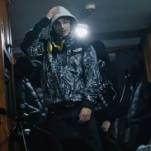The Lovers On The Bridge
“Paris can stay in bed.” — last line, The Lovers On The Bridge
There was no chance that Leos Carax’s delirious 1991 opus The Lovers On The Bridge was going to be anything but a total fiasco, because it needed to be a fiasco in order to realize its ambitions. In that way, it’s like Francis Ford Coppola’s Apocalypse Now, another grand, crazy, spectacularly indulgent vision that needed to go wrong in order to be right. Coppola needed to go upriver with Captain Willard, and he needed the hassles of Martin Sheen having a heart attack, Dennis Hopper tweaking, Marlon Brando improvising at $1 million a week, and the myriad other tortures dredged up by a production quagmire that lasted 238 days. Could anyone argue that Apocalypse Now would have been nearly the same experience had it been completed on time and on budget? It’s a film indelibly stained by the conditions that brought it into existence.
Heading into The Lovers On The Bridge, critic-turned-filmmaker Carax established himself as a volatile torchbearer for the French New Wave and arguably the most promising director associated with the “cinéma du look,” an ’80s movement that married the slickness of Hollywood filmmaking with a prevailing mood of cool alienation. (Touchstone “cinéma du look” films: Luc Besson’s La Femme Nikita and Jean-Jacques Beineix’s Diva and Betty Blue.) Carax broke through with a pair of quick-and-dirty l’amour fou romances, Boy Meets Girl and Mauvais Sang (Bad Blood), both heavily indebted to the Jean-Luc Godard of Breathless, but invested with a more fanciful spirit. Take my favorite sequence from the latter, where the nimble Denis Lavant expresses his passion for Juliette Binoche to the tune of David Bowie’s “Modern Love,” a moment when real feelings are abstracted into bold, irrepressible fantasy.
Three years in the making, The Lovers On The Bridge—a crude, Miramaxed translation of the more particular French title Les Amants Du Pont-Neuf—doubled down on the flights of fancy in Carax’s first two movies, and wound up being the French equivalent of Heaven’s Gate. The thorniest issue was the primary location of the film, Paris’ Pont-Neuf Bridge, a crumbling yet deeply romantic landmark where its two vagrant lovers spend most of their time. Carax and his producers requested three months’ use of the well-trafficked bridge, but the mayor allotted only three weeks, and even that sliver of time was cut short by a freak injury that took lead actor Lavant out of commission. It was resolved that a full-scale replica of the Pont-Neuf (and its outlying backdrop) would be built over a Montpellier lake, but huge cost overruns and hiccups in financing shut down production on several occasions. When the film was finally completed at an estimated $28 million price tag, it was a predictable box-office flop in France in 1991, and it sat in Miramax’s vaults for eight years until the benevolent Martin Scorsese stepped in and helped liberate it under the Miramax Zoë label.








































